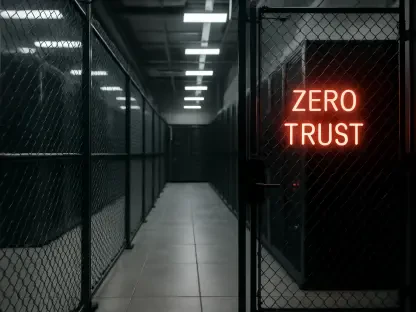Introducing Matilda Bailey, a networking specialist known for her expertise in cellular, wireless, and next-gen network solutions. Matilda brings a wealth of knowledge in simplifying complex network infrastructures through strategic and technical standardization. In this interview, we explore the intricacies of network standardization, its impact on digital transformation, and the strategic initiatives necessary for modern network management.
Can you explain what you mean by the term “brownfield complexity” in the context of network standardization?
Brownfield complexity refers to the challenges posed by existing network infrastructures that have evolved over time without unified standardization. These networks often consist of multiple layers of legacy technologies, making them resistant to modern upgrades and prone to inefficiencies. It’s about untangling decades of organic growth to make room for predictable, scalable solutions.
How does the lack of network standardization impact digital transformation initiatives within an organization?
Without standardization, networks become bottlenecks in digital transformation. Manual interventions are often needed for routine changes, which slow down innovation and adaptation to new business needs. This can result in increased operational costs and heightened business risks, ultimately undermining the agility and responsiveness necessary for successful digital transformations.
What are the main benefits of implementing standardized, automation-ready infrastructure in network management?
Standardized, automation-ready infrastructures significantly reduce the time and risks associated with network changes. They enhance operational predictability, allowing similar functions across various network environments to be managed consistently. This uniformity not only facilitates rapid scaling and changes but also improves security and compliance, transforming network management from a liability into a strategic enabler.
How do strategic standardization and technical standardization differ from each other?
Strategic standardization focuses on the overarching business outcomes such as operational predictability, change velocity, and risk management. It’s about aligning network architectures with business needs and enabling efficient management. On the other hand, technical standardization is more granular, focusing on engineering consistency and technical specifications essential for interoperability and performance.
Can you elaborate on the three business-critical areas for strategic standardization: operational predictability, change velocity, and risk management?
Operational predictability ensures that similar business functions adopt consistent network patterns, fostering automated and scalable management. Change velocity is about decreasing the time and risk involved in executing network changes, thereby enhancing the organization’s responsiveness to market demands. Risk management involves the reduction of errors through consistent configurations and practices, improving security and incident response.
What are the key steps in the Design-Driven Transformation Framework for successful network standardization?
The framework involves two main tracks: optimizing the current state and defining the future state. Current state optimization focuses on remedying configuration inconsistencies that hinder automation, while future state definition involves drafting a target architecture that aligns with business objectives. This blueprint guides both standardization efforts and automation initiatives.
How does design-driven automation complement standardization efforts?
Design-driven automation treats network configuration as a reflection of documented design intentions. It relies on consistency within the network environment to implement automated solutions effectively. This approach not only complements standardization by streamlining configurations but also fosters further standardization as inconsistencies are identified and eliminated through automation.
What role does executive sponsorship play in the standardization process?
Executive sponsorship is crucial as it provides the necessary leadership and resources for standardization initiatives, which often require a considerable upfront investment for significant long-term benefits. Executives help align these initiatives with organizational goals, ensuring they are prioritized and adequately supported across all levels of the organization.
When starting a standardization initiative, what criteria should be used to identify network areas with the most business impact?
Focus on network areas that directly affect critical business operations or involve frequent changes. These might include infrastructure supporting essential services or those linked to dynamic business requirements. Prioritizing such areas ensures that standardization efforts yield significant improvements in operational efficiency and support key business outcomes.
How important is establishing governance in maintaining network standards as they evolve?
Establishing governance is vital as it ensures that network standards are consistently applied and adapted as the organization evolves. Governance frameworks provide the structure needed to manage changes and maintain compliance with standardization efforts, preventing drift and ensuring sustained benefits.
What types of business outcomes should be measured to gauge the success of standardization efforts?
Success can be gauged by metrics like service delivery lead time, incident resolution speed, and change fail rates. Though technical indicators like automation coverage are important, the focus should be on business-centric outcomes – those that reflect improved operational efficiency, reduced costs, and enhanced responsiveness.
How can standardization result in cultural changes within operational teams, and what steps are necessary to guide this transformation?
Standardization shifts the focus from individual craftsmanship to systematic, standards-based operations. This requires a cultural shift within teams, emphasizing collaboration and adherence to standardized processes. Guidance involves clear communication of benefits, leadership support, and training to embrace new practices and mindsets.
What are the three key enablers for technology investments supporting standardization?
The three enablers include configuration management tools, automated validation systems, and orchestration platforms. Configuration management facilitates consistency, automated validation ensures compliance through continuous monitoring, and orchestration platforms enable seamless implementation of changes across network devices.
Can you describe the role of configuration management tools in network standardization?
Configuration management tools play a pivotal role by identifying and addressing configuration drift within the network. They ensure that configurations remain aligned with standards and simplify the auditing process by providing integration with existing documentation and change management systems.
How do automated validation systems contribute to maintaining network standards?
Automated validation systems continuously verify that network configurations comply with defined standards. By using AI-driven analysis, they transition compliance from a reactive, manual process to one of proactive, intelligent monitoring, predicting and preventing potential issues before they escalate.
What are orchestration platforms, and how do they support network standardization?
Orchestration platforms streamline the implementation of standardized changes across multiple network devices and vendors. They maintain audit trails and support rollback capabilities, ensuring that changes are consistent and traceable, thus reinforcing standards while enabling agile adaptations.
What are common pitfalls that executives should avoid in standardization initiatives?
Executives should avoid expecting immediate ROI, treating standardization as merely a technical project, striving for perfection over progress, and ignoring operational constraints. These pitfalls can derail standardization efforts by misaligning them with business realities or focusing on unrealistic outcomes instead of incremental improvements.
Why is it unrealistic to expect immediate ROI from standardization efforts?
Standardization is a foundational investment aimed at establishing a robust framework that supports future automation and operational efficiencies. The benefits accrue over time as the infrastructure becomes more streamlined and adaptable to technological advancements, rather than delivering quick financial returns.
How can treating standardization as a technical project limit its effectiveness?
Viewing standardization solely through a technical lens ignores its widespread impact on business processes and culture. It requires changes in how teams operate and should be treated as a holistic transformation initiative, not just a series of technical upgrades.
What is the significance of balancing operational constraints with transformation goals during standardization?
Balancing these elements is crucial as it ensures that standardization efforts do not disrupt business continuity. The transformation should enhance, not hinder, operational effectiveness, aligning with business goals while respecting the existing operational landscape.
How can network standardization transform a network from a liability into a strategic asset?
Standardization simplifies complex networks, reducing maintenance burdens and operational risks. This transformation enhances network reliability and agility, allowing it to respond swiftly to business needs, thereby turning it into a strategic advantage rather than a maintenance challenge.
In what ways can network standardization enable competitive differentiation for an organization?
Network standardization paves the way for rapid adaptation to market demands and innovation. A standardized, agile network infrastructure empowers organizations to deploy new services faster and more reliably, offering a significant edge over less agile competitors.
How should organizations align standardization with their broader digital transformation objectives?
Organizations should anchor their standardization strategies to their digital transformation goals by ensuring that network improvements support wider business innovation and agility. This alignment ensures resources are allocated effectively, maximizing the impact of both standardization and digital initiatives.
What potential future capabilities can standardized network infrastructure enable for businesses?
Standardized network infrastructure lays the groundwork for advanced automation and AI-driven orchestration, supporting innovations like IoT and edge computing. These capabilities allow businesses to explore new service models and enhance scalability and customer responsiveness strategies.
What insights can you share about your experience and role in promoting network standardization at Khadga Consulting and within the industry overall?
At Khadga Consulting, we advocate for blending technical efficiency with strategic alignment. Our approach involves close collaboration with clients to foster an understanding that network standardization supports their long-term business ambitions. Through industry engagement, we highlight the importance of not just technical conformity but also strategic design that propels business growth and innovation.
Do you have any advice for our readers?
My advice is to embrace network standardization as an integral part of your business strategy. Focus on aligning it with your overall objectives and be patient. The journey requires commitment but offers transformative benefits by unlocking new levels of efficiency and positioning your network as a catalyst for future growth.









